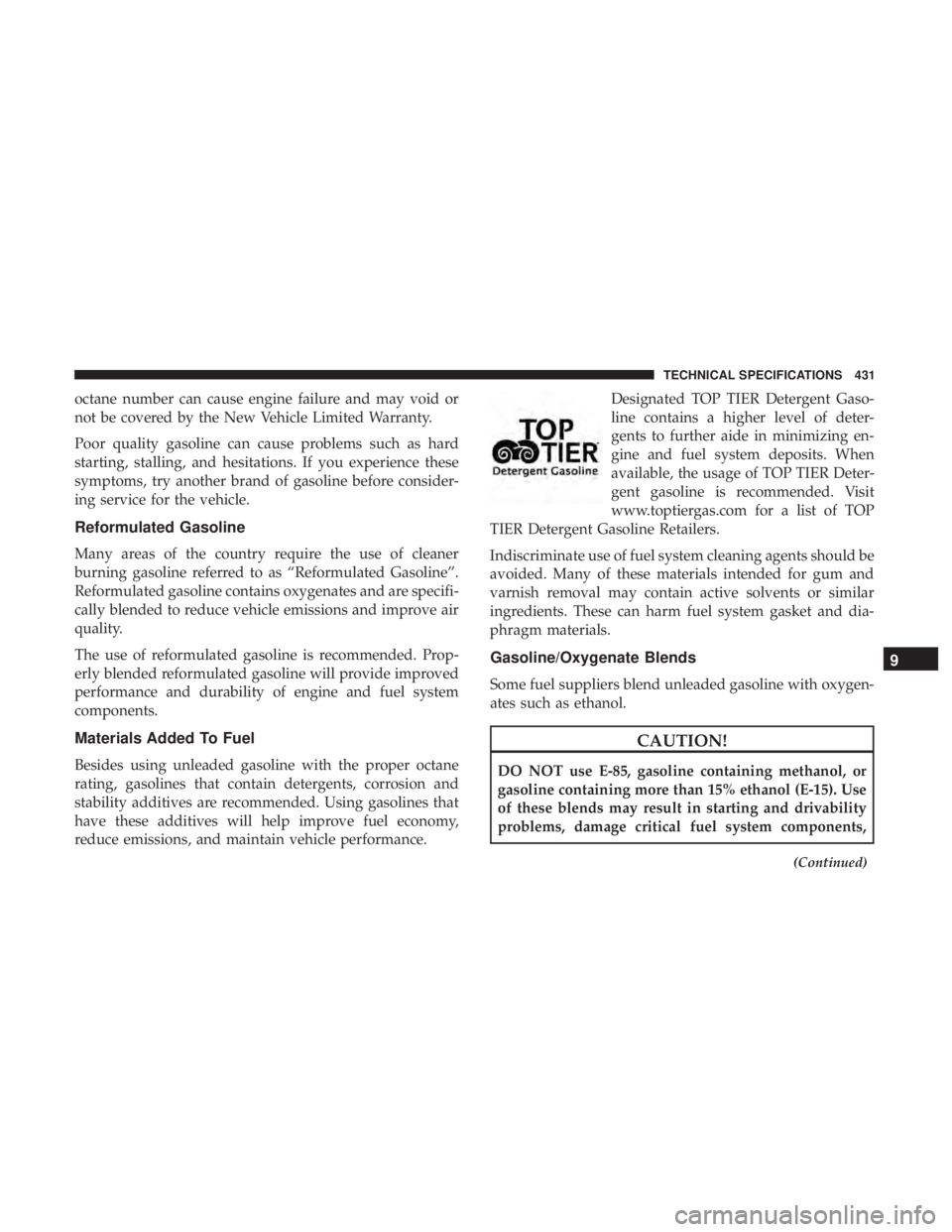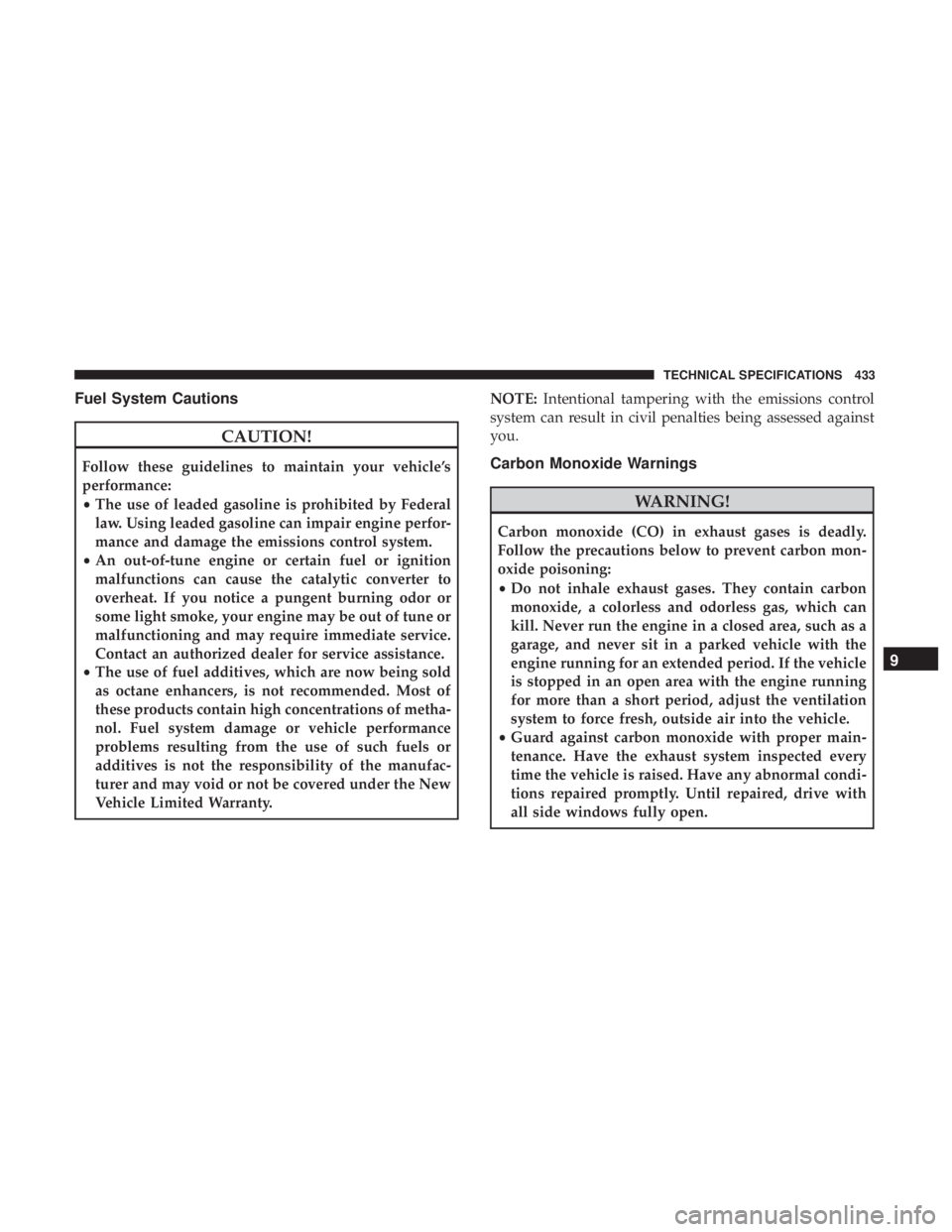2019 DODGE CHARGER fuel additives
[x] Cancel search: fuel additivesPage 433 of 560

octane number can cause engine failure and may void or
not be covered by the New Vehicle Limited Warranty.
Poor quality gasoline can cause problems such as hard
starting, stalling, and hesitations. If you experience these
symptoms, try another brand of gasoline before consider-
ing service for the vehicle.
Reformulated Gasoline
Many areas of the country require the use of cleaner
burning gasoline referred to as “Reformulated Gasoline”.
Reformulated gasoline contains oxygenates and are specifi-
cally blended to reduce vehicle emissions and improve air
quality.
The use of reformulated gasoline is recommended. Prop-
erly blended reformulated gasoline will provide improved
performance and durability of engine and fuel system
components.
Materials Added To Fuel
Besides using unleaded gasoline with the proper octane
rating, gasolines that contain detergents, corrosion and
stability additives are recommended. Using gasolines that
have these additives will help improve fuel economy,
reduce emissions, and maintain vehicle performance.Designated TOP TIER Detergent Gaso-
line contains a higher level of deter-
gents to further aide in minimizing en-
gine and fuel system deposits. When
available, the usage of TOP TIER Deter-
gent gasoline is recommended. Visit
www.toptiergas.com for a list of TOP
TIER Detergent Gasoline Retailers.
Indiscriminate use of fuel system cleaning agents should be
avoided. Many of these materials intended for gum and
varnish removal may contain active solvents or similar
ingredients. These can harm fuel system gasket and dia-
phragm materials.
Gasoline/Oxygenate Blends
Some fuel suppliers blend unleaded gasoline with oxygen-
ates such as ethanol.
CAUTION!
DO NOT use E-85, gasoline containing methanol, or
gasoline containing more than 15% ethanol (E-15). Use
of these blends may result in starting and drivability
problems, damage critical fuel system components,
(Continued)
9
TECHNICAL SPECIFICATIONS 431
Page 435 of 560

Fuel System Cautions
CAUTION!
Follow these guidelines to maintain your vehicle’s
performance:
•The use of leaded gasoline is prohibited by Federal
law. Using leaded gasoline can impair engine perfor-
mance and damage the emissions control system.
• An out-of-tune engine or certain fuel or ignition
malfunctions can cause the catalytic converter to
overheat. If you notice a pungent burning odor or
some light smoke, your engine may be out of tune or
malfunctioning and may require immediate service.
Contact an authorized dealer for service assistance.
• The use of fuel additives, which are now being sold
as octane enhancers, is not recommended. Most of
these products contain high concentrations of metha-
nol. Fuel system damage or vehicle performance
problems resulting from the use of such fuels or
additives is not the responsibility of the manufac-
turer and may void or not be covered under the New
Vehicle Limited Warranty. NOTE:
Intentional tampering with the emissions control
system can result in civil penalties being assessed against
you.Carbon Monoxide Warnings
WARNING!
Carbon monoxide (CO) in exhaust gases is deadly.
Follow the precautions below to prevent carbon mon-
oxide poisoning:
• Do not inhale exhaust gases. They contain carbon
monoxide, a colorless and odorless gas, which can
kill. Never run the engine in a closed area, such as a
garage, and never sit in a parked vehicle with the
engine running for an extended period. If the vehicle
is stopped in an open area with the engine running
for more than a short period, adjust the ventilation
system to force fresh, outside air into the vehicle.
• Guard against carbon monoxide with proper main-
tenance. Have the exhaust system inspected every
time the vehicle is raised. Have any abnormal condi-
tions repaired promptly. Until repaired, drive with
all side windows fully open.
9
TECHNICAL SPECIFICATIONS 433
Page 437 of 560

NOTE:
•Use seasonally adjusted E-85 fuel (ASTM D5798). With
non-seasonally adjusted E-85 fuel, hard starting and
rough idle following start up may be experienced even if
the above recommendations are followed, especially
when the ambient temperature is below 32°F (0°C).
•
Some additives used in regular gasoline are not fully
compatible with E-85 and may form deposits in your
engine. To eliminate driveability issues that may be caused
by these deposits, a supplemental gasoline additive, such
as Mopar Injector Cleanup or Techron may be used.
Selection Of Engine Oil For Flexible Fuel Vehicles
(E-85) And Gasoline Vehicles
FFV vehicles operated on E-85 require specially formulated
engine oils. These special requirements are included in
Mopar engine oils, and in equivalent oils meeting FCA US
Material Standard MS-6395. It is recommended that engine
oils that are API Certified and meet the requirements of
Material Standard MS-6395 be used. MS-6395 contains
additional requirements, developed during extensive fleet
testing, to provide additional protection to FCA US LLC
engines.
Starting
The characteristics of E-85 fuel make it unsuitable for use
when ambient temperatures fall below 0°F (-18°C). In the
range of 0°F (-18°C) to 32°F (0°C), an increase in the time it
takes for your engine to start may be experienced, and a
deterioration in driveability (sags and/or hesitations) until
the engine is fully warmed up. These issues may be
improved with the use of seasonally adjusted E-85 fuel.
NOTE: Use of the engine block heater (if equipped) may
improve engine start time when using E-85 fuel when the
ambient temperature is less than 32°F (0°C).
Cruising Range
Because E-85 fuel contains less energy per gallon/liter than
gasoline, an increase in fuel consumption will be experi-
enced. The miles per gallon (mpg)/kilometers per liter and
the driving range will decrease by approximately 30%,
compared to gasoline operation.9
TECHNICAL SPECIFICATIONS 435
Page 542 of 560

About Your Brakes........................ .428
Adaptive Cruise Control (ACC) (Cruise Control) . . . .253
Adding Engine Coolant (Antifreeze) .............390
Adding Fuel ............................. .287
Adding Washing Fluid ...................... .374
Additives, Fuel ........................... .431
Adjust Forward ................................48
Rearward ...............................48
AirBag ................................ .191
Advance Front Air Bag ....................191
Air Bag Operation ....................... .193
Air Bag Warning Light .....................190
Driver Knee Air Bag ..................... .194
Enhanced Accident Response .............200, 358
Event Data Recorder (EDR) .................358
FrontAirBag .......................... .191
If Deployment Occurs .....................199
Knee Impact Bolsters ..................... .193
Maintaining Your Air Bag System .............201
Maintenance ........................... .201
Redundant Air Bag Warning Light ............191
Side Air Bags .......................... .194
Transporting Pets ....................... .219
Air Bag Light ...................... .136, 190, 220Air Cleaner, Engine (Engine Air Cleaner Filter)
......379
Air Conditioner Maintenance ..................380
Air Conditioner Refrigerant ................380, 381
Air Conditioner System ..................... .380
Air Conditioning ...................... .79, 85, 91
Air Conditioning Filter ....................93, 381
Air Conditioning, Operating Tips ................92
Air Filter ............................... .379
Air Pressure Tires................................. .407
Alarm Arm The System ...................... .35, 36
Panic ..................................22
Rearm The System ........................36
Security
Alarm....................... .34, 140
Alarm System Security Alarm ...........................34
All Wheel Drive Towing ............................... .357
All Wheel Drive (AWD) ..................... .396
Alterations/Modifications Vehicle .................................5
Android Auto ............................ .529
Antifreeze (Engine Coolant) ................389, 436
Disposal .............................. .392
540 INDEX
Page 547 of 560

Flexible Fuel VehiclesCruising Range ......................... .435
Engine Oil ............................ .435
Fuel Requirements ....................... .434
Maintenance ........................... .436
Replacement Parts ....................... .436
Starting .............................. .435
Flooded Engine Starting ..................... .232
Floor Console .............................112
Fluid, Brake .......................... .438, 440
Fluid Capacities ........................... .436
Fluid Leaks .............................. .223
Fluid Level Checks Brake ................................ .393
Cooling System ......................... .389
Engine Oil ............................ .373
Transfer Case .......................... .396
Fluids And Lubricants ...................... .438
Fog Lights ................................70
Fold-Flat Seats .............................43
Folding Rear Seats ..........................46
Forward Collision Warning ....................168
Four-Way Hazard Flasher .....................307
Freeing A Stuck Vehicle ..................... .355Fuel
................................... .429
Additives ............................. .431
Clean Air ............................. .431
Ethanol ........................... .431, 434
Flexible .............................. .434
Gasoline .............................. .429
Materials Added ........................ .431
Methanol ............................. .431
Octane Rating ....................429, 430, 438
Requirements ....................... .429, 436
Specifications .......................... .438
Tank Capacity .......................... .436
Fuses .................................. .315
Garage
Door Opener (HomeLink) ...............105
Gasoline, Clean Air ........................ .431
Gasoline, Reformulated ..................... .431
Gear Ranges ............................. .242
Glass Cleaning ........................... .424
Gross Axle Weight Rating .................291, 293
Gross Vehicle Weight Rating ...............291, 292
GVWR ................................. .291
12
INDEX 545